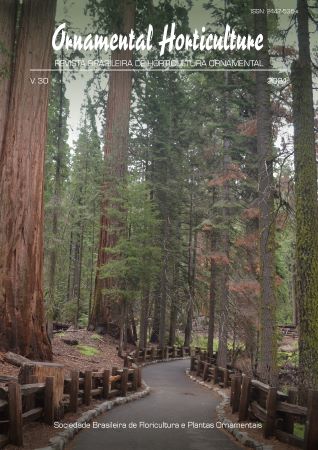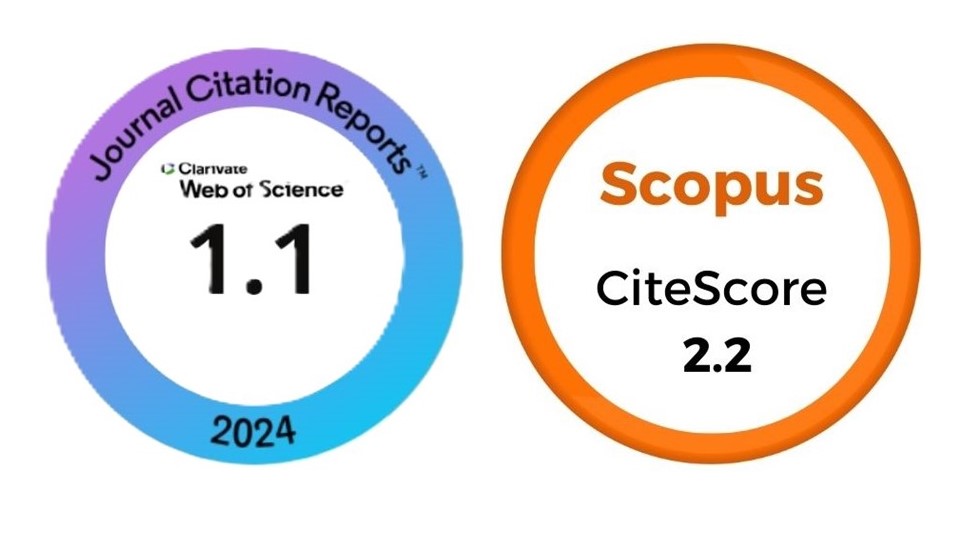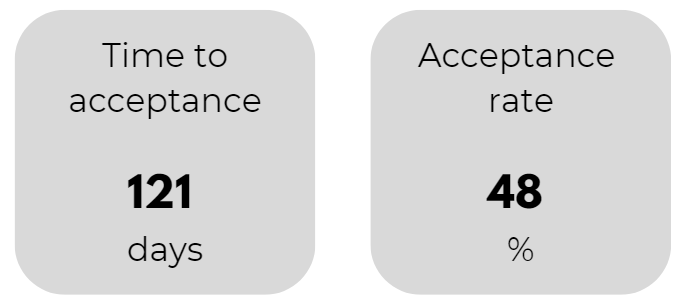Rhyncattleanthe Aurora’s José Françolin– um híbrido multiflora
DOI:
https://doi.org/10.1590/2447-536X.v30.e242763Palavras-chave:
híbrido de orquídea, floricultura, grupo híbrido de Cattleya, melhoramento de plantas, planta de vasoResumo
Aprodução brasileira de flores demanda novos materiais, especialmente para orquídeas. Aprodução híbrida pode ser uma forma de conservação genética, pois as plantas de espécies puras são submetidas a vários perigos na natureza. Este híbrido é considerado uma planta multiflora descendente de Guarianthe bowringiana. Rhyncattleanthe Aurora’s José Françolin é um híbrido inovador derivado de um cruzamento entre Rhyncattleanthe Aurora’s Blue Pride #1, uma planta com 25% de Guarianthe bowringiana que dá o caráter multiflora com flores bem formadas, e Rhyncolaeliocattleya Turandot “Guaxupé”, um clone conhecido com características excepcionais. Rhyncattleanthe Aurora’s José Françolin produz cachos de até cinco flores de tamanho médio a grande, bem armadas, com substância pesada variando de rosa claro a lavanda escuro e pétalas largas, muitas delas com um labelo largo também, as flores são levemente perfumadas e bem adaptadas a climas mais quentes. Os melhores clones foram selecionados com base no parâmetro genético da largura da pétala (PW, h2 = 0,854) em vez do diâmetro natural (D, h2 = 0,935) devido ao melhor formato da flor e equilíbrio entre os outros segmentos florais. Alguns clones superiores estão sendo selecionados como plantas reprodutoras e para clonagem, para uma contagem floral superior à RC Turandot e flores de bom tamanho (mais de 10 mm em cada dimensão do que a RCT Aurora’s Blue Pride #1). Parâmetros genéticos como a largura da pétala são úteis para selecionar clones superiores.
Downloads
Referências
ALLENDORF, F.W.; LEARY, R.F.; SPRUELL, P.; WENBURG, J.K. The problems with hybrids: Setting conservation guidelines. Trends in Ecology and Evolution, v.16, p.613-622, 2001. https://doi.org/10.1016/S0169-5347(01)02290-X
ARIDA, B.L.; SCOPECE, G.; MACHADO, R.M.; MORAES, A.P.; FORNI-MARTINS, E.; PINHEIRO, F. Reproductive barriers and fertility of two neotropical orchid species and their natural hybrid. Evolutionary Ecology, v.35, p.41-64, 2021.
BALILASHAKI, K.; DEHGHANIAN, Z.; GOUGERDCHI, V.; KAVUSI, E.; FEIZI, F.; TANG, X.; VAHEDI, M.; HOSSAIN, M.M. Progress and Prospect of Orchid Breeding: An Overview. In: TIWARI, P.; CHEN, J.-T. (Ed.). Advances in Orchid Biology, Biotechnology and Omics. Singapore: Springer Nature Singapore, 2023. p.261-283.
BROWN, J.C.; JESUS CORRÊA-NETO, J. DE; RIBEIRO, C.F.; OLIVEIRA, M.L. The impact of agricultural colonization and deforestation on orchid bees (Apidae: Euglossini) in the Brazilian Amazon. Biological Conservation, v.293, p.110560, 2024. https://doi.org/10.1016/j.biocon.2024.110560
CARDOSO, J.C. Laeliocattleya “Brazilian Girl Rosa”: v de orquídea para cultivo em vaso. Horticultura Brasileira, v.28, p.378-381, 2010. https://doi.org/10.1590/S0102-05362010000300024
CARDOSO, J.C.; MARTINELLI, A.P.; TEIXEIRA DA SILVA, J.A. A novel approach for the selection of Cattleya hybrids for precocious and season-independent flowering. Euphytica, v.210, p.143-150, 2016. https://doi.org/10.1007/s10681-016-1714-2
FELIX, L.; GUERRA, M. Variation in chromosome number and the basic number of subfamily Epidendroideae (Orchidaceae). Botanical Journal of the Linnean Society, v.163, p.234-278, 2010. https://doi.org/10.1111/j.1095-8339.2010.01059.x
FRANCISQUETI, A.M.; MARIN, R.R.; HENGLING, M.M.; HOSOMI, S.T.; PRITCHARD, H.W.; CUSTÓDIO, C.C.; MACHADO-NETO, N.B. Orchid seeds are not always short-lived in a conventional seed bank! Annals of Botany, v.133, p.mcae021, 2024. https://doi.org/10.1093/aob/mcae021
GOVAERTS, R. World Checklist of Vascular Plants (WCVP) –Version 12.Board of Trustees of the Royal Botanic Gardens, Kew, 2023. Available at: <https://kew.iro.bl.uk/concern/datasets/32f77ea6-0f7b-4b2d-b7b3-173ed4ca2d6a?locale=en>. Accessed on: 8 jun 2024.
HINSLEY, A.; DE BOER, H.J.; FAY, M.F.; GALE, S.W.; GARDINER, L.M.; GUNASEKARA, R.S.; KUMAR, P.; MASTERS, S.; METUSALA, D.; ROBERTS, D.L. A review of the trade in orchids and its implications for conservation. Botanical Journal of the Linnean Society, v.186, p.435-455, 2018. https://doi.org/10.1093/botlinnean/box083
HINSLEY, A.; LEE, T.E.; HARRISON, J.R.; ROBERTS, D.L. Estimating the extent and structure of trade in horticultural orchids via social media. Conservation Biology, v.30, p.1038-1047, 2016. https://doi.org/https://doi.org/10.1111/cobi.12721
JUNQUEIRA, A.H.; PEETZ, M. Brazilian consumption of flowers and ornamental plants: habits, practices and trends. Ornamental Horticulture, v.23, p.178-184, 2017. https://doi.org/10.14295/oh.v23i2.1070
MACHADO NETO, N.B. Selection parameters of a new “coerulea” multiflora hybrid: Cattlianthe aurora’s blue pride. Crop Breeding and Applied Biotechnology, v.19, p.487-490, 2019. https://doi.org/10.1590/1984-70332019v19n4c70
MACHADO-NETO, N.B.; FILETI, J.F.; CUSTÓDIO, C.C. Cattleya Aurora’s Little Ian: a novelty mini semper-flowering material and a genetic parameter for superior clone selection. Horticultura Brasileira, v.40, p.115-118, 2022. https://doi.org/10.1590/s0102-0536-20220115
MINAMIGUCHI, J.Y.; CUSTODIO, C.C.; MACHADO-NETO, N.B. A new Dendrobium cultivar: Den.‘Aurora’s Orange Hana’. Ornamental Horticulture, v.29, p.264-268, 2023. https://doi.org/10.1590/2447-536X. v29i2.2591
MURASHIGE, T.; SKOOG, F. A revised medium for rapid growth and bio assays with tobacco tissue cultures. Physiologia plantarum, p.473-497, 1962.
REITER, N.; DIMON, R.; FREESTONE, M. Saving orchids from extinction: The RBGV orchid conservation program’ex situ’collection. Australasian Plant Conservation: Journal of the Australian Network for Plant Conservation, v.29, p.11-13, 2020.
SILVA, G.M.; VARELLA, T.L.; KARSBURG, I.V.; SANTANA, T.N.; CARVALHO, I.F.; SILVA AÑEZ, R.B. DA; ROSSI, A.A.B.; SILVA, M.L. DA. Cytogenetic characterization of species and hybrids of orchids of Cattleya genus. Cytologia, v.82, p.137-140, 2017. https://doi.org/10.1508/cytologia.82.137.
SOLTIS, P.S.; GITZENDANNER, M.A. Molecular systematics and the conservation of rare species. Conservation Biology, v.13, p.471-483, 1999.
STULZER, G.C.G.; HOSHINO, R.T.; SUZUKI, A.B.P.; ALVES, G.A.C.; FARIA, R.T. DE. Primary hybrid of Cattleya forbesii x Cattleya loddigesii, a new brazilian orchid. Crop Breeding and Applied Biotechnology, v.19, p.364-367, 2019. https://doi.org/10.1590/1984- 70332019v19n3c50
SUAREZ-GUERRA, L.; TELLEZ-BELTRAN, G. Encyvola’Cachita’. Orchid hybrid of wide adaptability to the tropical conditions. Cultivos Tropicales, v.41, p.e08, 2020.
SUBRAHMANYESWARI, T.; VERMA, S.K.; GANTAIT, S. One-step in vitro protocol for clonal propagation of Dendrobium Yuki White, a high value ornamental orchid hybrid. South African Journal of Botany, v.146, p.883-888, 2022.
WITHNER, C.L. The Cattleyas and their relatives: a book in six parts. Vol. 1. The Cattleyas. Portland: Timber Press, 1988. 147p.
WU, J.-Y.; HSIEH, T.-F.; TSAO, C.-Y.; CHUANG, K.-C. Breeding of an Indigo Phalaenopsis by Intergeneric Hybridization: Rhynchonopsis Tariflor Blue Kid ‘1030-4’. HortScience, v.57, p.489-490, 2022. https://doi.org/10.21273/HORTSCI15944-21
YUAN, S.-C.; LEKAWATANA, S.; AMORE, T.D.; CHEN, F.-C.; CHIN, S.-W.; VEGA, D.M.; WANG, Y.-T. The global orchid market. In: The orchid genome. [s.l.]. Cham: Springer, 2021. p.1-28.
Downloads
Publicado
Edição
Seção
Licença
Copyright (c) 2024 Ornamental Horticulture

Este trabalho está licenciado sob uma licença Creative Commons Attribution 4.0 International License.








